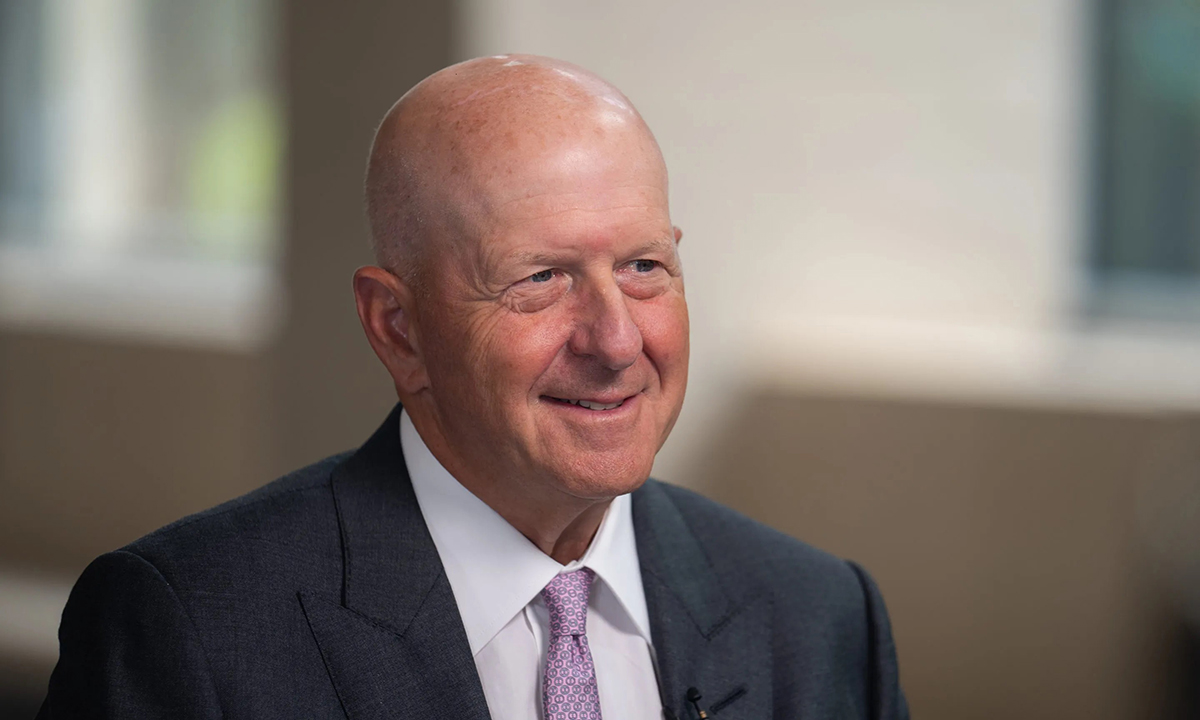
想在高盛(Goldman Sachs)找到一份工作比进哈佛(Harvard)还难。
不,这是事实。今年,这所美国历史最悠久的大学录取了3.6%的新生申请者。据高盛首席执行官大卫·所罗门(David Solomon)称,备受尊崇的投资银行高盛去年收到了“略多于”30万份应届大学毕业生的初级职位申请,他们聘用了约2500人。录取率低于1%,所罗门对此引以为豪。
所罗门在接受彭博社记者大卫·鲁宾斯坦(David Rubinstein)采访时说:“我们从世界各地的学校和大学中广泛招聘人才;我们努力扩大招聘范围。我们寻找的是拥有良好职业道德,以及主修科学、技术、工程和数学类学科的人才。我们公司有1万多名工程师,所以会雇佣很多工程师。”
他说,总的来说,这家银行寻找的是聪明、勤奋的毕业生,这些毕业生“追求卓越,求胜心切,并已证明自己有勇气和决心,也有能力取得成功,而且在失败时也能振作起来,继续前进”。
这些都是很高的要求,所罗门对此深有体会。他透露,就连首席执行官本人也曾被该银行拒绝过两次,直到1999年才最终超越了银行对他的偏见。
20世纪80年代初,拥有汉密尔顿学院(Hamilton College)政治学学位的年轻所罗门参加了纽约市“多家银行机构”的面试,最终被商业银行欧文信托公司(Irving Trust Company)录用,并参加了该公司的培训项目。所罗门在接受彭博社采访时表示:“我就是在那里开始了职业生涯,并开始学习金融知识,但在此之前我对金融知之甚少。”
虽然没有进入高盛,但也并非因为没有尝试。所罗门回忆说:“高盛是我致信要求面试的四五十家公司之一。它是回信的45家公司之一,并表示'承蒙垂爱,但您未通过筛选。'”
但这并不是这位银行业希望之星的终点。他说:“我在欧文信托公司工作一年左右时,还去高盛面试过一个分析师职位,表现不错。“但最终在最后一次面试中,我被一位合伙人拒绝了。那是在1985年。因此,我在职业生涯早期就两次遭到高盛的拒绝。”
然而所罗门坚持到底。他被前投资银行德崇证券(Drexel Burnham Lambert)招募到销售部门,然后转到贝尔斯登公司(Bear Stearns Cos,同样是前投行)。最终,高盛在1999年左右邀请所罗门加入,他在该公司上市后不久进行了横向调动。
所罗门告诉鲁宾斯坦:“我当时在贝尔斯登公司的职位相对较高。我对(高盛)真的不感兴趣。但[公司]不停地打电话给我。有一天我突然对他说,你知道吗?我确实应该考虑一下。于是在1999年夏天,也就是首次公开募股两个月后,我加入了公司。”
所罗门说,但他从未想过加入高管层;他只是想“学习、成长,做更多的业务”。此外,他还说,“你不可能以横向方式进入高盛,并期望自己成为首席执行官或管理合伙人。”
保持领先地位
然而,命运总是在不断变化:今年将是所罗门在高盛担任高管的第六个年头。鲁宾斯坦指出,在他任职期间,高盛的股票和市值“几乎翻了一番”。
事实上,所罗门非常关注这些主要指标。他说:“我们是一家上市公司,要为股东创造价值。在过去的六年里,我认为我们的市值增长了近1000亿美元……我们把公司的平均收入从340亿或350亿美元提高到了现在的500多亿美元。”
还有一些更抽象的目标。他说:“当你管理这样一个实力雄厚的组织时,其他事情也很重要,它们也会带来增长和进步。首先,我们是一家以客户为中心的企业,如果客户不信任公司(或)为他们服务的人——如果我们没有在长期关系中建立信任,没有为他们提供出色的服务——我们就无法取得其他成果。”(财富中文网)
译者:中慧言-王芳
想在高盛(Goldman Sachs)找到一份工作比进哈佛(Harvard)还难。
不,这是事实。今年,这所美国历史最悠久的大学录取了3.6%的新生申请者。据高盛首席执行官大卫·所罗门(David Solomon)称,备受尊崇的投资银行高盛去年收到了“略多于”30万份应届大学毕业生的初级职位申请,他们聘用了约2500人。录取率低于1%,所罗门对此引以为豪。
所罗门在接受彭博社记者大卫·鲁宾斯坦(David Rubinstein)采访时说:“我们从世界各地的学校和大学中广泛招聘人才;我们努力扩大招聘范围。我们寻找的是拥有良好职业道德,以及主修科学、技术、工程和数学类学科的人才。我们公司有1万多名工程师,所以会雇佣很多工程师。”
他说,总的来说,这家银行寻找的是聪明、勤奋的毕业生,这些毕业生“追求卓越,求胜心切,并已证明自己有勇气和决心,也有能力取得成功,而且在失败时也能振作起来,继续前进”。
这些都是很高的要求,所罗门对此深有体会。他透露,就连首席执行官本人也曾被该银行拒绝过两次,直到1999年才最终超越了银行对他的偏见。
20世纪80年代初,拥有汉密尔顿学院(Hamilton College)政治学学位的年轻所罗门参加了纽约市“多家银行机构”的面试,最终被商业银行欧文信托公司(Irving Trust Company)录用,并参加了该公司的培训项目。所罗门在接受彭博社采访时表示:“我就是在那里开始了职业生涯,并开始学习金融知识,但在此之前我对金融知之甚少。”
虽然没有进入高盛,但也并非因为没有尝试。所罗门回忆说:“高盛是我致信要求面试的四五十家公司之一。它是回信的45家公司之一,并表示'承蒙垂爱,但您未通过筛选。'”
但这并不是这位银行业希望之星的终点。他说:“我在欧文信托公司工作一年左右时,还去高盛面试过一个分析师职位,表现不错。“但最终在最后一次面试中,我被一位合伙人拒绝了。那是在1985年。因此,我在职业生涯早期就两次遭到高盛的拒绝。”
然而所罗门坚持到底。他被前投资银行德崇证券(Drexel Burnham Lambert)招募到销售部门,然后转到贝尔斯登公司(Bear Stearns Cos,同样是前投行)。最终,高盛在1999年左右邀请所罗门加入,他在该公司上市后不久进行了横向调动。
所罗门告诉鲁宾斯坦:“我当时在贝尔斯登公司的职位相对较高。我对(高盛)真的不感兴趣。但[公司]不停地打电话给我。有一天我突然对他说,你知道吗?我确实应该考虑一下。于是在1999年夏天,也就是首次公开募股两个月后,我加入了公司。”
所罗门说,但他从未想过加入高管层;他只是想“学习、成长,做更多的业务”。此外,他还说,“你不可能以横向方式进入高盛,并期望自己成为首席执行官或管理合伙人。”
保持领先地位
然而,命运总是在不断变化:今年将是所罗门在高盛担任高管的第六个年头。鲁宾斯坦指出,在他任职期间,高盛的股票和市值“几乎翻了一番”。
事实上,所罗门非常关注这些主要指标。他说:“我们是一家上市公司,要为股东创造价值。在过去的六年里,我认为我们的市值增长了近1000亿美元……我们把公司的平均收入从340亿或350亿美元提高到了现在的500多亿美元。”
还有一些更抽象的目标。他说:“当你管理这样一个实力雄厚的组织时,其他事情也很重要,它们也会带来增长和进步。首先,我们是一家以客户为中心的企业,如果客户不信任公司(或)为他们服务的人——如果我们没有在长期关系中建立信任,没有为他们提供出色的服务——我们就无法取得其他成果。”(财富中文网)
译者:中慧言-王芳
It’s harder to get a job at Goldman Sachs than it is to get into Harvard.
No, really. This year, the nation’s oldest university accepted 3.6% of its freshman applicants. Per CEO David Solomon, esteemed investment bank Goldman Sachs received “a little over” 300,000 applications for entry-level jobs from new college grads last year—and they hired about 2,500. That’s under a 1% acceptance rate, give or take—a percentage Solomon takes pride in.
“We recruit from a very broad selection of schools and universities all over the world; that’s one of the things that we’ve really tried to expand,” Solomon told Bloomberg’s David Rubinstein in an interview Thursday. “We look for a great work ethic, and majoring in a STEM kind of subject. We have over 10,000 engineers at the firm, so we hire a lot of engineers.”
On the whole, the bank looks for smart, hardworking grads who “believe in excellence, want to win, and have proven that they’ve got grit and determination and an ability to both succeed, but also when they fail to pick themselves up and dust themselves off and keep going,” he asid.
Those are tall orders, which Solomon knows well. Even the chief executive himself was rejected by the bank—twice—before finally making it past the velvet rope in 1999, he revealed.
Armed with a political science degree from Hamilton College, a young Solomon interviewed at “a bunch of banking institutions” in New York City in the early 1980s, and was eventually hired by the Irving Trust Company, a commercial bank, and placed in its training program. “That’s where I started my career and started to learn about finance, but I did not know much about it before that,” Solomon told Bloomberg.
It wasn’t Goldman, but not for lack of trying. “Goldman Sachs was one of 40 or 50 firms that I sent a letter to asking for an interview,” Solomon recalled. “It was one of the 45 that came back and said, no thank you.”
But that wasn’t the end of the road for the banking hopeful. “I also interviewed at Goldman for an analyst position when I’d been at Irving Trust for about a year, and I did well,” he said. “But ultimately I was turned down in the last interview, by a partner. That would have been in 1985. So I got two rejections from Goldman early in my career.”
Yet Solomon stayed the course. He was recruited to the sales desk at erstwhile investment bank Drexel Burnham Lambert, and then moved to (also erstwhile) Bear Stearns. Finally, Goldman came back around in 1999 and recruited Solomon to make a lateral move shortly after the firm went public.
“I was in a relatively senior position at Bear Stearns. And I really wasn’t interested [in Goldman],” Solomon told Rubinstein. “But [the company] kept calling and calling and calling. And he caught me on a day where suddenly I said, you know what? I should really look at this. And so in the summer of 1999, about two months after the IPO, I joined the firm.”
But he never had any aspirations towards joining the C-suite, Solomon said; he simply intended to “learn, grow and do more of the business.” And besides, he said, “there was no way you could come to Goldman Sachs laterally and expect you’d ever be the CEO or a managing partner.”
Staying on top
Yet fortunes are always changing: This year will mark Solomon’s sixth in the corner office. During his tenure, Rubinstein pointed out, Goldman’s stock and market cap have “more or less doubled.”
Indeed, Solomon is attuned to those major barometers. “We’re a public company, and we’re here to create value for our shareholders,” he said. “In the last six years, I think we’ve grown the market cap close to $100 billion… We’ve taken the average revenues of the firm from $34 or $35 billion to over $50 billion today.”
Then there are the more abstract goals. “When you’re stewarding a great organization like this, other things are important and lead to growth and improvement,” he said. “The first is, we are a client business, and if our clients don’t trust the firm [or] the people serving them—if we’re not building trust in long-term relationships and serving them with excellence and distinction—we won’t get those other outputs.”






